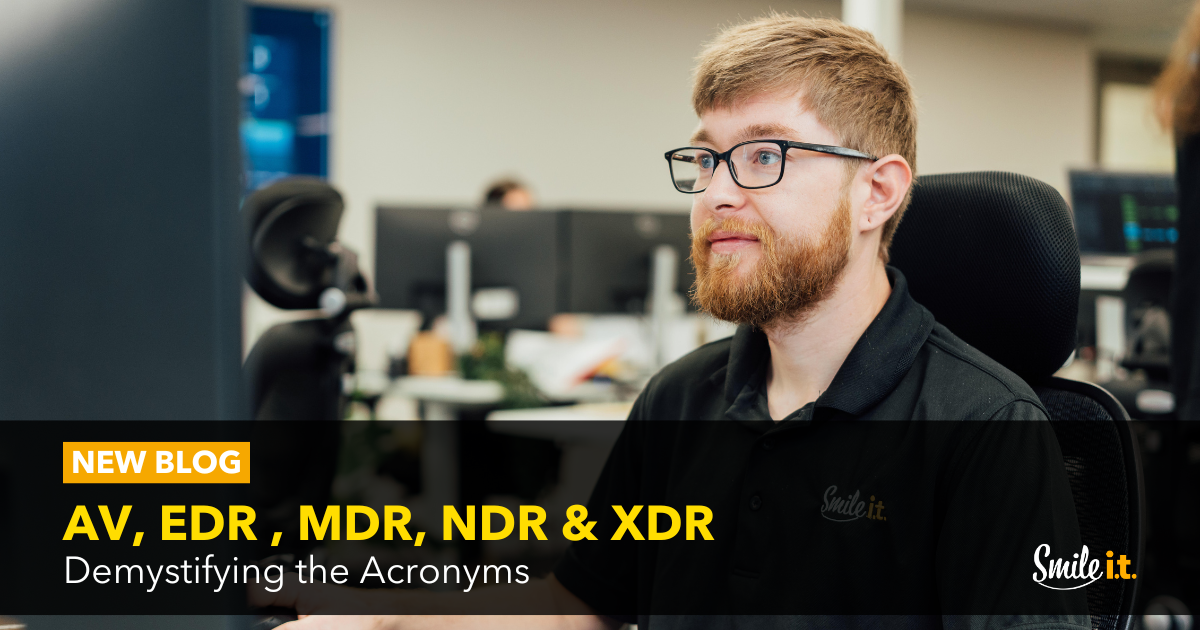The IT world loves a good acronym, and this couldn’t be more apparent than in the cyber security space. As cybercrime evolves and the solutions to thwarting hackers become more complex and developed, the list of acronyms is growing too.
At the end of the day, what matters most is that your business is as cyber safe as it can be. Understanding the endpoint security solutions available is a big step in empowering yourself to be exactly that. Today we’re going to look at five common and important security measures you can use to protect your business – AV, EDR, MDR, NDR and XDR.
We’re going to dive into what the acronyms stand for, what the solutions offer, the differences between each and which one offers the best protection for your business. Let’s take a look.
AV – Antivirus
AV stands for Antivirus, which is easily the most recognisable solution for most tech users as its been the standard for virus protection for many years now. Antivirus software protects computers from viruses and malware by creating a ‘blacklist’ of viruses and malware signatures.
If the AV scans your computer and finds anything matching the blacklist, it blocks it from executing, quarantines it or removes it from the system. Anything bad pops up, it gets shown the door. The thing is though, the AV software has to recognise it as bad. Meaning it needs to be on the blacklist, which means its already wreaked havoc in cyberspace. If you don’t update your AV software so that it recognises the latest threats out there, your defences against this havoc simply won’t be enough.
Next generation AV has started including something called ‘heuristic analysis’. This picks up on common malware behaviours and characteristics to identify it within a system, rather than relying solely on a blacklist of known malware. It’s a more proactive form of virus protection, helping block previously unseen malware.
If you’re running a business, AV is essential but you may find it’s not enough protection for your needs. With approaches like obfuscated malware and fileless attacks, hackers are finding ways to bypass it. The next level of endpoint security, EDR, provides a far more robust level of protection. Let’s learn more.
EDR – Endpoint Detection and Response
Endpoint Detection and Response is a multifaceted security solution that gives you the protection of AV, but builds on that to ensure a more complete approach to keeping cybercriminals out. For many businesses, given the array of endpoints they utilise and the constantly evolving threats, EDR has become an absolute necessity.
EDR goes beyond simply identifying that a file is a virus or malware. It’s constantly analysing the processes on a system, using integrated machine learning and advanced Ai to stop threats before they happen. It learns on the go, updating its threat baseline to determine whether running items should be allowed or not.
In this way, its effective at blocking so much more than malware. If it’s in use and configured properly it can protect against threats like ransomware, data theft and suspicious activity. It’ll even protect your systems against emerging threats that haven’t been seen before.
To sum it up, let’s look at a few points why EDR is taking over the mantle as the future of endpoint protection:
- Proactive: EDR has successfully used advanced technology to close the gaps AV left open to hackers.
- Less Resources: The days of a resource-heavy AV update slowing down your endpoint are over. EDR reduces scans and updates, while never compromising on consistent protection, even when offline.
- Wide–Ranging Protection: You’re protected against more than malware and viruses. The obfuscated malware and fileless attacks we mentioned earlier are taken care of, as well as much more.
- Easy Threat Investigation: EDR provides deep insights into a detected threat. This allows for security processes and controls to be adapted and updated.
MDR – Managed Detection and Response
Here’s the thing about EDR – it produces an incredible amount of data. The cyber security expertise needed to analyse it isn’t readily available to most businesses, who probably don’t have the budget to invest in an SOC (Security Operations Centre) anyhow.
So MDR, or Managed Detection and Response, steps up to the plate. It’s a cyber security solution that combines software with human expertise, enhancing the detection and response activities of EDR with a ‘managed’ approach. MDR is offered by a cyber security vendor, so they take on the responsibility of detection and response, constantly monitoring endpoints, networks and IT resources.
The human input of an MDR gives it a number of benefits. Firstly, threats can be comprehensively analysed, with any false positives weeded out. The most critical threats can be identified and focused on, creating a ‘threat triage’ that helps businesses in deciding what to prioritise in their security approach.
If you’re after a cybersecurity solution that leverages human investigation and advanced threat intelligence to identify and contain threats faster, MDR is what you need.
NDR – Network Detection and Response
Network Detection and Response Solutions, or NDR, have moved beyond signature-based detection. They use Artificial Intelligence, Machine Learning and data analytics to continuously analyse network traffic to build models of normal behaviour. Using these models, they can then identify anomalous traffic that looks suspicious and use incident response functionality to deal with them. This extra layer of security is important, particularly for large corporate networks.
XDR – Extended Detection and Response
XDR, or Extended Detection and Response, has evolved from Endpoint Detection and Response as a result of the exponential surge in cyberthreats. It collates and correlates data from multiple sources across an organisations technology stack, including applications, networks and endpoints. The condensed threat data is then able to be analysed by security teams for fast and easy forensic investigation of threats.
By siloing the data from different security silos across a technology stack, the analysis is streamlined as is the investigation and remediation.
Chat with Brisbane’s Cybersecurity Experts
If you recognise the incredible threat and disastrous repercussions of not having sufficient cybersecurity at your business, you’re on the right path towards securing your business. The next step involves contacting a cybersecurity expert like Smile IT. We’ll demystify the acronyms and decide on the best path towards making your company safe! We’ll also implement robust back up plans to keep your valuable business and client data safe in the event of a security incident.
Chat with one of our team today and we’ll answer any questions you might have.
When he’s not writing tech articles or turning IT startups into established and consistent managed service providers, Peter Drummond can be found kitesurfing on the Gold Coast or hanging out with his family!


